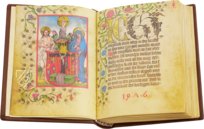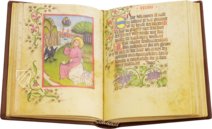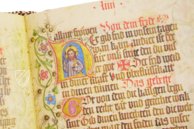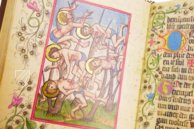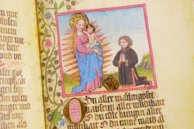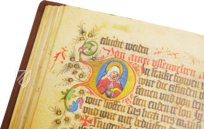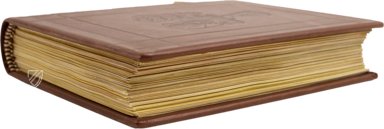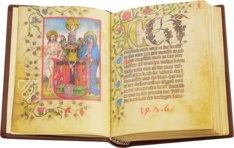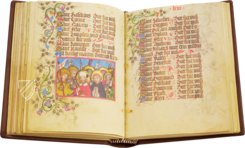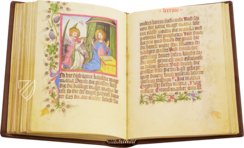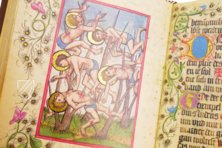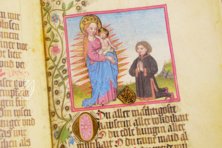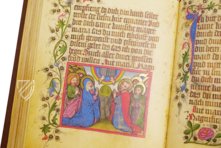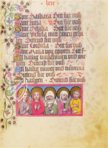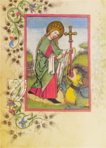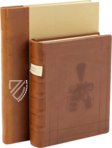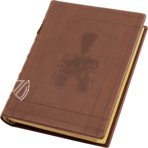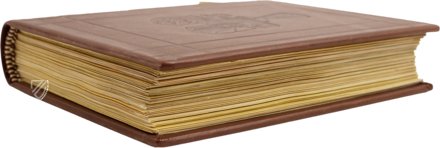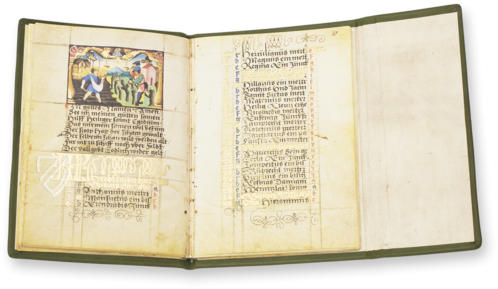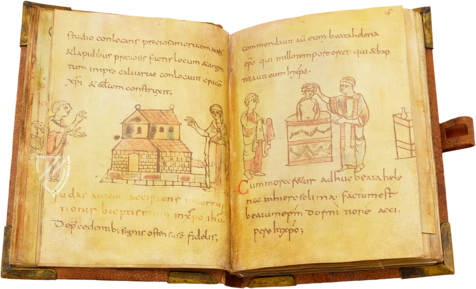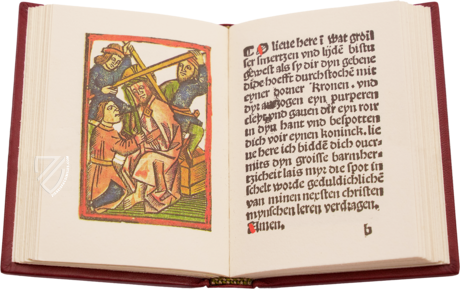Prayerbook of Georg II of Waldburg
The Prayerbook of Georg II of Waldburg is one of the few richly decorated German language prayer books and was created in 1476 for the Swabian nobleman Georg II von Waldburg (1430-1482) and his wife, Countess Anna von Kirchberg (ca. 1436-84). Like many other members of the House of Waldburg, Georg II was a Truchsess, a seneschal or steward ruling over Swabia during the absence of the Holy Roman Emperor. There are multiple depictions of him, each in different dress, as a praying patron in the 46 stunning miniatures richly decorated with gold and silver. In keeping with late medieval lay piety, which focused on the suffering of Christ, the Arma Christi, Instruments of the Passion, is a recurring pictorial theme throughout the manuscript. Particularly extraordinary is a unique hidden calendar in the Litany of All Saints, which, together with its precious illumination, makes the manuscript a rare treasure of book illumination.
Prayer Book of Georg II of Waldburg
Little is known of the origins of this manuscript and its history of ownership can only be traced back to the time before the year 1800. All that is certain is the patron of the manuscript, Georg II von Waldburg (1430-82), and the year it was completed, 1476, which is dated on the first page with his coat-of-arms. The text itself does not offer much in the way of clues as to where the manuscript originated, however a hidden calendar in the manuscript and other clues do.
It is not known how the manuscript came to Stuttgart or Ludwigsburg, where Duke Karl Eugen von Württemberg founded the Ducal Library in 1765. Thus, the entire period from 1476 to the late 18th-century remains a mystery. The original binding of the manuscript was replaced sometime in the first half of the 19th century with the current binding, whose simple appearance belies the value and significance of its contents: a masterfully illuminated, uniquely designed German prayerbook from the beginning of the Northern Renaissance.
A Splendid Codex for a Noble Knight
Aside from the depictions of religious figures and symbols, the Arma Christi included, Waldburg is depicted numerous times, usually kneeling before a holy figure, but also appears once as his namesake: St. George slaying a dragon. Altogether, 46 mostly full-page miniatures, seven historiated initials, and dozens of three- and four-line initials in bright colors and gold. The scribe used a Gothic Textura script that usually appears in liturgical manuscripts. It is therefore sometimes called “missal script” because it has predominantly shaped the image of missals from this period. The rubricator and illuminator then filled in the remaining spaces with headings, decorative initials, flowering tendrils, and miniatures as far as was possible.
The “Hidden Calendar”
Unlike most prayer books, this manuscript has no calendar at the beginning of the codex, but the Litany of All Saints beginning on fol. 64r has an internal structure that is made up of chronological blocks arranged according to the church year, which is completely unique for the Litany. The compiler was not aware of the appropriate number of saints nor their proper placement in the litany but appears to have used a calendar to select the saints without any serious theological considerations. This surely could not have been the result of a monastic scriptorium, whose experience compilers would never make such mistakes. Perhaps the selection of saints was made by Waldburg himself, because this amateurishness is inconsistent the quality of both the calligraphy and the illumination. However, similar chronological lists of saints point to a tradition from the old diocese of nearby Constance.
Clues in Local Saints
There is further evidence of the manuscript’s geographic providence: among the no less than 178 saints listed in the manuscript, which are divided into apostles, martyrs, confessors, and women is Saint Magnus of Füssen, the so-called Apostle of the Allgäu. He was strongly venerated in the countryside around Waldsee, where Georg II resided, which thus points to the Allgäu region of Upper Swabia. This is also attested to by the fact that Magnus was patron of the nearby Premonstratensian monastery at Schussenried. Other local saints include Bishop Gebhard of Constance, Bishop Narcissus of Augsburg, St. Einsiedler Meinrad, and the rarely mentioned Ulrich von Zell. As such the work must have emerged in an area where the old dioceses of Constance and Augsburg overlap. A likely candidate would be an atelier or court artist in the town of Kempten, the oldest urban settlement in Germany, as the possible place of manufacture.
Codicology
- Alternative Titles
- Waldburg-Gebetbuch
Gebetbuch Georgs II. von Waldburg - Size / Format
- 122 pages / 17.5 × 13.2 cm
- Origin
- Germany
- Date
- 1476
- Epochs
- Style
- Genre
- Language
- Script
- Gothic Textura
- Illustrations
- 46 richly adorned and partly gilded and silvered miniatures, seven historiated initials, countless decorated initials
- Content
- German-language prayer book
- Patron
- Georg II of Waldburg and his wife Anna
Prayerbook of Georg II of Waldburg
Christ’s Coat of Arms
Flanked by Jesus bearing the wounds of the Crucifixion and the Virgin Mary, the crest of this shield consists of a golden helmet with the Crown of Thorns and the anointing Hand of God. It bears the Arma Christi or Instruments of the Passion, which are presented here as heraldic devices numbering nearly 20 in all: True Cross, pillar, rooster, whip, reed, Holy Lance, Holy Sponge, dice, Veil of Veronica, Peter’s sword, hammer and nails, burial shroud and tomb, vessel of myrrh, and the heads of various figures of the Passion as well as the hand of Pontius Pilate.

Prayerbook of Georg II of Waldburg
Patron Portrait – Intercessory Prayer
Georg II von Waldburg appears several times throughout the manuscript and can be identified by his coat of arms – three black lions on a field of gold. Almost always depicted kneeling in prayer and bareheaded with curly brown hair, he is sometimes fashionably dressed as a courtier in all black with red shoes, sometimes clad in a golden suit of armor with a red sword at his hip. This miniature stresses the role of the Virgin Mary in Catholic theology as intercessor on behalf of those who pray to her.
Although in an open field, Georg has had the foresight to bring his own kneeler with him as though he were in church praying before an altar. The Virgin Mary looks to her son, who in turn kneels on a cloud before God the Father appearing as a crowned king with a scepter and globus cruciger. A white dove representing the Holy Spirit is perched next to God’s ear as though it were giving counsel, and grisaille angels can be seen in the blue background of Heaven, which is separated from Earth by a rainbow.

#1 Waldburg-Gebetbuch
- Treatises / Secular Books
- Apocalypses / Beatus
- Astronomy / Astrology
- Bestiaries
- Bibles / Gospels
- Chronicles / History / Law
- Geography / Maps
- Saints' Lives
- Islam / Oriental
- Judaism / Hebrew
- Single Leaf Collections
- Leonardo da Vinci
- Literature / Poetry
- Liturgical Manuscripts
- Medicine / Botany / Alchemy
- Music
- Mythology / Prophecies
- Psalters
- Other Religious Books
- Games / Hunting
- Private Devotion Books
- Other Genres
- Afghanistan
- Armenia
- Austria
- Belgium
- Belize
- Bosnia and Herzegovina
- China
- Colombia
- Costa Rica
- Croatia
- Cyprus
- Czech Republic
- Denmark
- Egypt
- El Salvador
- Ethiopia
- France
- Germany
- Greece
- Guatemala
- Honduras
- Hungary
- India
- Iran
- Iraq
- Israel
- Italy
- Japan
- Jordan
- Kazakhstan
- Kyrgyzstan
- Lebanon
- Liechtenstein
- Luxembourg
- Mexico
- Morocco
- Netherlands
- Palestine
- Panama
- Peru
- Poland
- Portugal
- Romania
- Russia
- Serbia
- Spain
- Sri Lanka
- Sweden
- Switzerland
- Syria
- Tajikistan
- Turkey
- Turkmenistan
- Ukraine
- United Kingdom
- United States
- Uzbekistan
- Vatican City
- A. Oosthoek, van Holkema & Warendorf
- Aboca Museum
- Ajuntament de Valencia
- Akademie Verlag
- Akademische Druck- u. Verlagsanstalt (ADEVA)
- Aldo Ausilio Editore - Bottega d’Erasmo
- Alecto Historical Editions
- Alkuin Verlag
- Almqvist & Wiksell
- Amilcare Pizzi
- Andreas & Andreas Verlagsbuchhandlung
- Archa 90
- Archiv Verlag
- Archivi Edizioni
- Arnold Verlag
- ARS
- Ars Magna
- ArtCodex
- AyN Ediciones
- Azimuth Editions
- Badenia Verlag
- Bärenreiter-Verlag
- Belser Verlag
- Belser Verlag / WK Wertkontor
- Benziger Verlag
- Bernardinum Wydawnictwo
- BiblioGemma
- Biblioteca Apostolica Vaticana (Vaticanstadt, Vaticanstadt)
- Bibliotheca Palatina Faksimile Verlag
- Bibliotheca Rara
- Boydell & Brewer
- Bramante Edizioni
- Bredius Genootschap
- Brepols Publishers
- British Library
- C. Weckesser
- Caixa Catalunya
- Canesi
- CAPSA, Ars Scriptoria
- Caratzas Brothers, Publishers
- Carus Verlag
- Casamassima Libri
- Centrum Cartographie Verlag GmbH
- Chavane Verlag
- Christian Brandstätter Verlag
- Circulo Cientifico
- Club Bibliófilo Versol
- Club du Livre
- CM Editores
- Collegium Graphicum
- Collezione Apocrifa Da Vinci
- Comissão Nacional para as Comemorações dos Descobrimentos Portugueses
- Coron Verlag
- Corvina
- CTHS
- D. S. Brewer
- Damon
- De Agostini/UTET
- De Nederlandsche Boekhandel
- De Schutter
- Deuschle & Stemmle
- Deutscher Verlag für Kunstwissenschaft
- DIAMM
- Droz
- E. Schreiber Graphische Kunstanstalten
- Ediciones Boreal
- Ediciones Grial
- Ediclube
- Edições Inapa
- Edilan
- Editalia
- Edition Deuschle
- Edition Georg Popp
- Edition Leipzig
- Edition Libri Illustri
- Editiones Reales Sitios S. L.
- Éditions de l'Oiseau Lyre
- Editions Medicina Rara
- Editorial Casariego
- Editorial Mintzoa
- Editrice Antenore
- Editrice Velar
- Edizioni Edison
- Egeria, S.L.
- Eikon Editores
- Electa
- Emery Walker Limited
- Enciclopèdia Catalana
- Eos-Verlag
- Ephesus Publishing
- Ernst Battenberg
- Eugrammia Press
- Extraordinary Editions
- Fackelverlag
- Facsimila Art & Edition
- Facsimile Editions Ltd.
- Facsimilia Art & Edition Ebert KG
- Faksimile Verlag
- Feuermann Verlag
- Folger Shakespeare Library
- Franco Cosimo Panini Editore
- Friedrich Wittig Verlag
- Fundación Hullera Vasco-Leonesa
- G. Braziller
- Gabriele Mazzotta Editore
- Gebr. Mann Verlag
- Gesellschaft für graphische Industrie
- Getty Research Institute
- Giovanni Domenico de Rossi
- Giunti Editore
- Graffiti
- Grafica European Center of Fine Arts
- Guido Pressler
- Guillermo Blazquez
- Gustav Kiepenheuer
- H. N. Abrams
- Harrassowitz
- Harvard University Press
- Helikon
- Hendrickson Publishers
- Henning Oppermann
- Herder Verlag
- Hes & De Graaf Publishers
- Hoepli
- Holbein-Verlag
- Houghton Library
- Hugo Schmidt Verlag
- Idion Verlag
- Il Bulino, edizioni d'arte
- ILte
- Imago
- Insel Verlag
- Insel-Verlag Anton Kippenberger
- Instituto de Estudios Altoaragoneses
- Instituto Nacional de Antropología e Historia
- Istituto dell'Enciclopedia Italiana - Treccani
- Istituto Ellenico di Studi Bizantini e Postbizantini
- Istituto Geografico De Agostini
- Istituto Poligrafico e Zecca dello Stato
- Italarte Art Establishments
- Jan Thorbecke Verlag
- Johnson Reprint Corporation
- Josef Stocker
- Josef Stocker-Schmid
- Jugoslavija
- Karl W. Hiersemann
- Kasper Straube
- Kaydeda Ediciones
- Kindler Verlag / Coron Verlag
- Kodansha International Ltd.
- Konrad Kölbl Verlag
- Kurt Wolff Verlag
- La Liberia dello Stato
- La Linea Editrice
- La Meta Editore
- Lambert Schneider
- Landeskreditbank Baden-Württemberg
- Leo S. Olschki
- Les Incunables
- Liber Artis
- Library of Congress
- Libreria Musicale Italiana
- Lichtdruck
- Lito Immagine Editore
- Lumen Artis
- Lund Humphries
- M. Moleiro Editor
- Maison des Sciences de l'homme et de la société de Poitiers
- Manuscriptum
- Martinus Nijhoff
- Maruzen-Yushodo Co. Ltd.
- MASA
- Massada Publishers
- McGraw-Hill
- Metropolitan Museum of Art
- Militos
- Millennium Liber
- Müller & Schindler
- Nahar - Stavit
- Nahar and Steimatzky
- National Library of Wales
- Neri Pozza
- Nova Charta
- Oceanum Verlag
- Odeon
- Orbis Mediaevalis
- Orbis Pictus
- Österreichische Staatsdruckerei
- Oxford University Press
- Pageant Books
- Parzellers Buchverlag
- Patrimonio Ediciones
- Pattloch Verlag
- PIAF
- Pieper Verlag
- Plon-Nourrit et cie
- Poligrafiche Bolis
- Presses Universitaires de Strasbourg
- Prestel Verlag
- Princeton University Press
- Prisma Verlag
- Priuli & Verlucca, editori
- Pro Sport Verlag
- Propyläen Verlag
- Pytheas Books
- Quaternio Verlag Luzern
- Reales Sitios
- Recht-Verlag
- Reichert Verlag
- Reichsdruckerei
- Reprint Verlag
- Riehn & Reusch
- Roberto Vattori Editore
- Rosenkilde and Bagger
- Roxburghe Club
- Salerno Editrice
- Saltellus Press
- Sandoz
- Sarajevo Svjetlost
- Schöck ArtPrint Kft.
- Schulsinger Brothers
- Scolar Press
- Scrinium
- Scripta Maneant
- Scriptorium
- Shazar
- Siloé, arte y bibliofilia
- SISMEL - Edizioni del Galluzzo
- Sociedad Mexicana de Antropología
- Société des Bibliophiles & Iconophiles de Belgique
- Soncin Publishing
- Sorli Ediciones
- Stainer and Bell
- Studer
- Styria Verlag
- Sumptibus Pragopress
- Szegedi Tudomànyegyetem
- Taberna Libraria
- Tarshish Books
- Taschen
- Tempus Libri
- Testimonio Compañía Editorial
- Thames and Hudson
- The Clear Vue Publishing Partnership Limited
- The Facsimile Codex
- The Folio Society
- The Marquess of Normanby
- The Richard III and Yorkist History Trust
- Tip.Le.Co
- TouchArt
- TREC Publishing House
- TRI Publishing Co.
- Trident Editore
- Typis Regiae Officinae Polygraphicae
- Union Verlag Berlin
- Universidad de Granada
- University of California Press
- University of Chicago Press
- Urs Graf
- Vallecchi
- Van Wijnen
- VCH, Acta Humaniora
- VDI Verlag
- VEB Deutscher Verlag für Musik
- Verlag Anton Pustet / Andreas Verlag
- Verlag Bibliophile Drucke Josef Stocker
- Verlag der Münchner Drucke
- Verlag für Regionalgeschichte
- Verlag Styria
- Vicent Garcia Editores
- W. Turnowski Ltd.
- W. Turnowsky
- Waanders Printers
- Wiener Mechitharisten-Congregation (Wien, Österreich)
- Wissenschaftliche Buchgesellschaft
- Wissenschaftliche Verlagsgesellschaft
- Wydawnictwo Dolnoslaskie
- Xuntanza Editorial
- Zakład Narodowy
- Zollikofer AG




